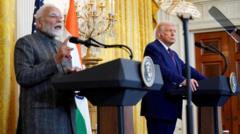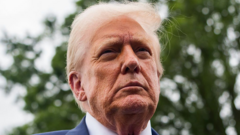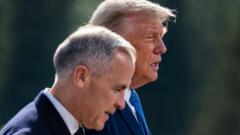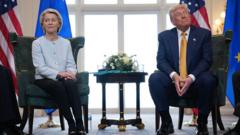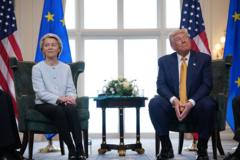As the trade war between China and the United States intensifies, with unprecedented tariffs in place, both economies face uncertainty. Yet, China possesses unique strengths that could influence the outcome of this confrontation.
China's Strengths in the Ongoing US Trade War
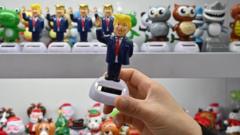
China's Strengths in the Ongoing US Trade War
A look into China's strategic advantages amid escalating tariffs in the US-China trade conflict
China's enduring strength amid tariff escalations
The ongoing trade war between the US and China has reached critical levels, with tariffs soaring to shocking heights—245% on Chinese exports and 125% on American imports. Businesses and consumers are feeling the ripple effects as fears of a global recession loom over the international economy. While US President Donald Trump portrays toughness in this economic duel, Chinese President Xi Jinping is poised to resist pressure with a belief in China's resilience and potential.
China’s vast consumer market creates a buffer against tariffs, giving it a unique ability to withstand pain, albeit within limits. With over a billion citizens, China’s consumer potential is vast, and recent measures to enhance domestic spending, including subsidies and investments, provide a cushion for exporters facing tariffs. As pointed out by trade expert Mary Lovely, the Chinese leadership is determined to endure hardships to resist perceived US aggression. Furthermore, as an authoritarian regime, the Chinese government is less concerned about short-term public backlash, which allows it to take actions that may summon unrest, particularly given the current economic climate.
China has pivoted towards technological advancement, accelerating investments into sectors such as electric vehicles and AI to boost its economic profile beyond being the "world's factory." While the US has attempted to move supply chains out of China, these efforts face challenges in replicating China’s robust infrastructure. Beijing's aggressive commitment to innovation, exemplified by extensive funding plans for AI, positions it competitively against US companies.
Additionally, while the US formerly held sway as the foremost trading partner for China, the nation is now exploring greater trade ties with regions like Southeast Asia and Africa as part of its Belt and Road Initiative—a strategic move to diminish dependency on US markets for essential goods. China has thus reduced its imports of critical crops such as soybeans from American sources, emphasizing self-sufficiency.
A notable aspect of the trade war is China’s leverage in the bond market; it holds a staggering $700 billion in US government bonds. However, looking to use this as a “weapon” may have financial repercussions for China itself—selling these bonds could destabilize its currency, indicating a delicate balance of power.
One of the most significant realizations in this conflict is China's monopoly over rare earth elements, essential for many technologically advanced products. With an overwhelming percentage of global rare earth production and refining capabilities, Beijing can restrict these materials to assert influence over the trade war.
In essence, while the United States strives to maneuver economically and politically, the complexities of China's strategy present formidable challenges amidst the fallout of these tariffs. As tensions rise, the evolving dynamics of the trade relationship may redefine economic partnerships and global markets moving forward.
The ongoing trade war between the US and China has reached critical levels, with tariffs soaring to shocking heights—245% on Chinese exports and 125% on American imports. Businesses and consumers are feeling the ripple effects as fears of a global recession loom over the international economy. While US President Donald Trump portrays toughness in this economic duel, Chinese President Xi Jinping is poised to resist pressure with a belief in China's resilience and potential.
China’s vast consumer market creates a buffer against tariffs, giving it a unique ability to withstand pain, albeit within limits. With over a billion citizens, China’s consumer potential is vast, and recent measures to enhance domestic spending, including subsidies and investments, provide a cushion for exporters facing tariffs. As pointed out by trade expert Mary Lovely, the Chinese leadership is determined to endure hardships to resist perceived US aggression. Furthermore, as an authoritarian regime, the Chinese government is less concerned about short-term public backlash, which allows it to take actions that may summon unrest, particularly given the current economic climate.
China has pivoted towards technological advancement, accelerating investments into sectors such as electric vehicles and AI to boost its economic profile beyond being the "world's factory." While the US has attempted to move supply chains out of China, these efforts face challenges in replicating China’s robust infrastructure. Beijing's aggressive commitment to innovation, exemplified by extensive funding plans for AI, positions it competitively against US companies.
Additionally, while the US formerly held sway as the foremost trading partner for China, the nation is now exploring greater trade ties with regions like Southeast Asia and Africa as part of its Belt and Road Initiative—a strategic move to diminish dependency on US markets for essential goods. China has thus reduced its imports of critical crops such as soybeans from American sources, emphasizing self-sufficiency.
A notable aspect of the trade war is China’s leverage in the bond market; it holds a staggering $700 billion in US government bonds. However, looking to use this as a “weapon” may have financial repercussions for China itself—selling these bonds could destabilize its currency, indicating a delicate balance of power.
One of the most significant realizations in this conflict is China's monopoly over rare earth elements, essential for many technologically advanced products. With an overwhelming percentage of global rare earth production and refining capabilities, Beijing can restrict these materials to assert influence over the trade war.
In essence, while the United States strives to maneuver economically and politically, the complexities of China's strategy present formidable challenges amidst the fallout of these tariffs. As tensions rise, the evolving dynamics of the trade relationship may redefine economic partnerships and global markets moving forward.

